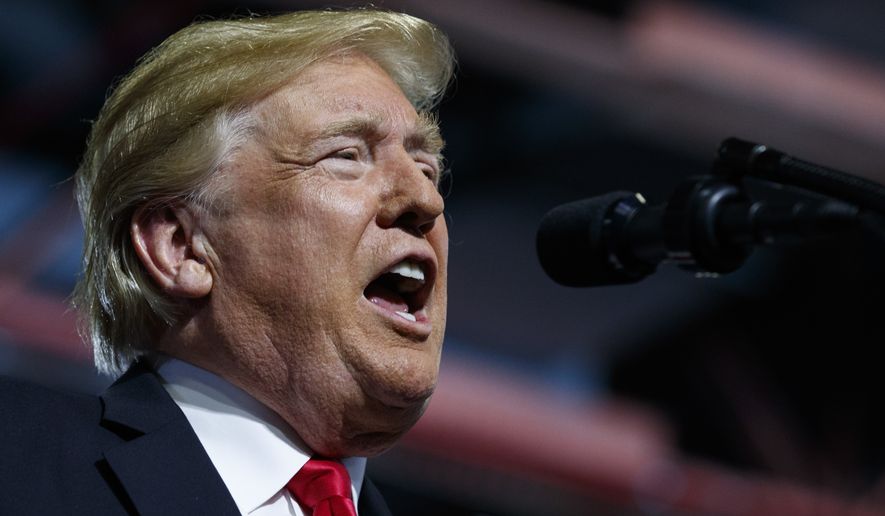The U.S.-China trade war is set to dramatically escalate Friday as threatened higher tariffs go into effect, and President Trump is going into battle with virtually no support from the Republican Party establishment.
But that doesn’t mean Mr. Trump is fighting alone.
The president’s get-tough stance on China is bolstered by an electoral base that for years has been moving away from the GOP’s long-held free trade orthodoxy, according to conservative and business leaders who themselves oppose protectionist tariffs in trade disputes.
“We’ve recognized a lot of our own base — Republican primary voters, conservatives — they are not as favorable toward free trade anymore,” said Tim Phillips, president Americans for Prosperity, a conservative advocacy group that steadfastly opposes higher duties.
“This didn’t start with the president,” he added. “The drift started well before him, and it’s not going to end with this tariff and protectionist move.”
Americans for Prosperity plans a multiyear multi-million-dollar campaign to corral Republican voters back into the free trade stable.
Mr. Trump said Thursday that the 25 percent tariff on $34 billion worth of Chinese goods was just the beginning of his crackdown. Higher duties would hit another $16 billion worth of goods in two weeks, telling reporters en route to a rally in Montana he is prepared to considered another $500 billion in trade duties on Chinese goods if Beijing refuses to compromise.
“It’s only on China,” said Mr. Trump.
Chinese President Xi Jinping’s government accused the U.S. of “firing first” in the trade war and vowed to shoot back.
“China will not bow in the face of threats and blackmail, nor will it be shaken in its resolve to defend global free trade,” said Gao Feng, spokesman for China’s Commerce Ministry.
Mr. Trump insists that he is a free-trader, but that for too long the U.S. has allowed what he calls “dumb trade,” charging low tariffs at home while allowing foreign rivals to impose high tariffs and other barriers to U.S. exports, leading to huge trade deficits.
With China, critics say, the uneven playing field is further tilted by Beijing’s theft or forced transfer of American businesses’ intellectual property.
The president blames Beijing’s unfair trade practices for driving up America’s annual trade deficit with China to $375 billion.
In the U.S., support for the president standing up to China extends to blue-collar Democratic voters who crossed party lines in 2016 to help send Mr. Trump to the White House. It’s also a position long championed by Democrats, although they have been mostly silent since Mr. Trump took up the cause.
The tariff threats have caused wild swings on Wall Street. However, stocks were strong Thursday with the Dow Jones Industrial average gaining 181 points to close at 24,356.
Still, Mr. Trump’s resolve and that of Americans facing higher import prices will be tested in a trade clash with China and other countries.
Economists expect a tit-for-tat tariffs to drive up prices paid by U.S. consumers and force job cuts in industries that rely on raw materials from China or sales to the huge Chinese market.
The higher U.S. duties will hit products including Chinese-made machinery, auto parts, medical equipment, rare earth metals and electronic cigarette devices.
Beijing is retaliating with tariffs on such U.S. goods as soybeans, sorghum and cotton, in many cases selecting products intended to inflict pain on areas that supported Mr. Trump politically in 2016..
“We have to at some point stand up to China. I think it is better to do it now that five or 10 years from now,” said Stephen Moore, an economist at the conservative Heritage Foundation who is close to the president.
He said China, with 4 percent of its GDP tied to trade with the U.S., has much more to lose in a trade war.
“We both lose if this gets to be a tit-for-tat situation, but China would be thrown into a recession if it couldn’t trade with the United States,” said Mr. Moore.
Recent polls have shown voters are split over the president’s trade moves and on tariffs on China.
Quinnipiac University national poll last month found that voters support the idea of tariffs on China 52 percent to 36 percent. Republicans overwhelmingly approved, 78 percent to 15 percent.
However, a Wall Street Journal/NBC News showed that 51 percent of registered voters were either uncomfortable or had reservations voting for a candidate in the midterms who backed tariffs on countries such as Canada, German and China.
Mr. Trump’s tariffs on steel and aluminum hit all those counties, but he leveled the most sweeping new duties on China.
“It’s classic Trump,” said GOP strategist and pollster Jim McLaughlin, who did work for the Trump campaign in 2016. He credited the president with going after China without clear-cut support in the polls, as well as following through on trade policies that were a top campaign promise in 2016.
“It’s one of those things where he’s doing what he said he would do and he’s fighting for working-class people,” said Mr. McLaughlin. “You don’t see anybody protesting other than the country-club Republicans.”
• Dave Boyer can be reached at dboyer@washingtontimes.com.
• S.A. Miller can be reached at smiller@washingtontimes.com.




Please read our comment policy before commenting.